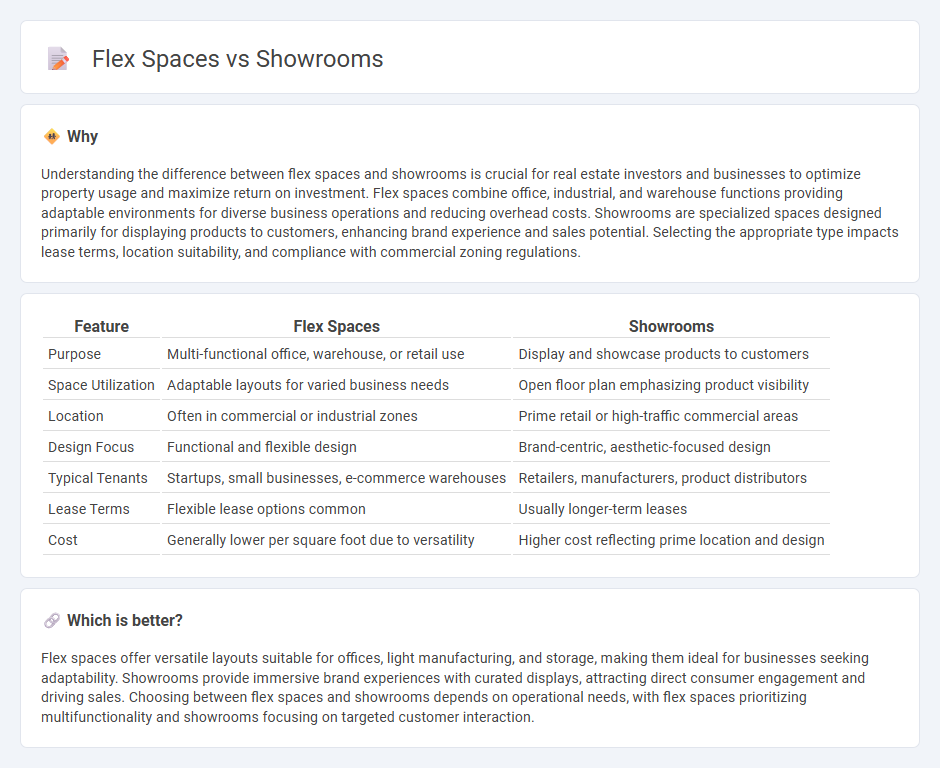
Flex spaces offer adaptable commercial environments that can be customized for various business needs, providing versatility not found in traditional office layouts. Showrooms focus specifically on displaying products and creating immersive brand experiences, often designed to attract and engage customers. Explore the differences between flex spaces and showrooms to determine which best suits your real estate strategy.
Why it is important
Understanding the difference between flex spaces and showrooms is crucial for real estate investors and businesses to optimize property usage and maximize return on investment. Flex spaces combine office, industrial, and warehouse functions providing adaptable environments for diverse business operations and reducing overhead costs. Showrooms are specialized spaces designed primarily for displaying products to customers, enhancing brand experience and sales potential. Selecting the appropriate type impacts lease terms, location suitability, and compliance with commercial zoning regulations.
Comparison Table
| Feature | Flex Spaces | Showrooms |
|---|---|---|
| Purpose | Multi-functional office, warehouse, or retail use | Display and showcase products to customers |
| Space Utilization | Adaptable layouts for varied business needs | Open floor plan emphasizing product visibility |
| Location | Often in commercial or industrial zones | Prime retail or high-traffic commercial areas |
| Design Focus | Functional and flexible design | Brand-centric, aesthetic-focused design |
| Typical Tenants | Startups, small businesses, e-commerce warehouses | Retailers, manufacturers, product distributors |
| Lease Terms | Flexible lease options common | Usually longer-term leases |
| Cost | Generally lower per square foot due to versatility | Higher cost reflecting prime location and design |
Which is better?
Flex spaces offer versatile layouts suitable for offices, light manufacturing, and storage, making them ideal for businesses seeking adaptability. Showrooms provide immersive brand experiences with curated displays, attracting direct consumer engagement and driving sales. Choosing between flex spaces and showrooms depends on operational needs, with flex spaces prioritizing multifunctionality and showrooms focusing on targeted customer interaction.
Connection
Flex spaces and showrooms are interconnected in real estate as both offer versatile, adaptable environments tailored to meet dynamic business needs, enhancing operational efficiency and customer engagement. Flex spaces provide customizable areas that can transition between office, warehouse, and retail functions, while showrooms utilize these adaptable spaces to display products effectively and attract clientele. This synergy supports businesses in optimizing real estate investment by combining functionality with visual merchandising strategies.
Key Terms
Zoning
Showrooms typically require commercial zoning that permits retail or display activities, ensuring compliance with local regulations for customer access and product presentation. Flex spaces, combining retail, office, and sometimes light industrial uses, often fall under mixed-use or flexible zoning categories, offering adaptability but requiring careful verification of permissible activities. Explore detailed zoning guidelines in your area to maximize the functional benefits and legal compliance of showrooms and flex spaces.
Usable Square Footage
Showrooms maximize usable square footage by emphasizing open, flexible layouts designed to showcase products with minimal obstructions, enhancing customer experience and display visibility. Flex spaces prioritize adaptability, offering multi-functional areas that can be reconfigured for various uses but may sacrifice some dedicated showroom space efficiency. Explore how strategic space planning impacts operational effectiveness and customer engagement by learning more about showroom and flex space designs.
Customization
Showrooms offer highly customizable environments tailored to showcase specific products with controlled lighting, layout, and branding elements that enhance customer experience. Flex spaces provide versatile, adaptable areas designed for multiple uses, allowing businesses to reconfigure layouts and functionalities quickly to meet evolving needs. Explore detailed comparisons to discover which option aligns best with your customization goals.
Source and External Links
Showroom - Wikipedia - A showroom is a large space used to display products or show entertainment, often seen in retail for items like cars, furniture, and apparel.
Kitchen Showrooms - Sub-Zero, Wolf, and Cove - Offers immersive kitchen experiences with stunning vignettes across the United States.
Kitchen & Bath Design Center - San Jose - Features a 6000 sq ft showroom for kitchen and bathroom remodeling supplies in San Jose.
SHOWROOM - Provides an edited collection of women's designer clothing with locations in Austin and Kiawah Island.
 dowidth.com
dowidth.com